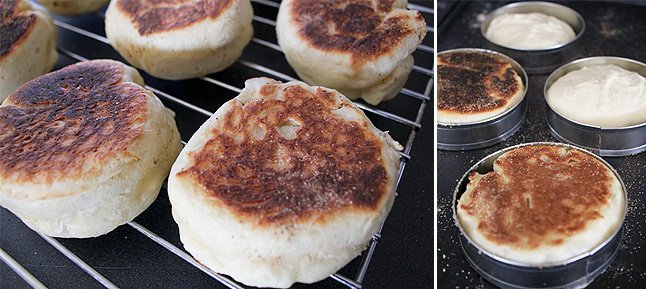Pour ceux qui aimeraient se lancer dans les oeufs Bénédicte du début à la fin, ça commence ici…
LE MUFFIN ANGLAIS :
C’est la base des Bénédicte. Sur internet, vous trouverez des dizaines de recettes pour les faire vous-même, mais la plupart donnent des résultats qui sont plus proches des crumpets (ci-dessous)
J’ai finalement opté pour une recette de Michael Ruhlman. Il utilise une pâte humide qui est presque comme une pâte à crêpe, mais avec des tonnes de levure et, juste avant la cuisson, une pincée de levure dissoute dans l’eau pour créer encore plus de coins et recoins. Les perfectionnistes peuvent acheter des formes spéciales pour muffins anglais, ou vous pouvez utiliser n’importe quelle boîte aux extrémités découpées. N’oubliez pas de saupoudrer un peu de farine de maïs sur la surface de cuisson, texture supplémentaire importante pour des muffins anglais corrects. Enfin, faites attention de ne pas les brûler. Si la surface du muffin commence à devenir trop brune, vous pouvez toujours terminer leur cuisson dans le four.
LA COUCHE DU MILIEU :
Le choix est tombé sur une tranche de jambon cuit un peu épaisse et passée à la poële quelque minutes pour ajouter un peu de couleur.
L’OEUF POCHE :
Tout ce que dont vous avez besoin, c’est : une casserole d’eau qui est sur le point de frémir, un peu de vinaigre blanc, une petite assiette, une écumoire , et quatre minutes de votre journée. C’est tout! Aucune technique, et des œufs parfaits à chaque fois.

LA SAUCE HOLLANDAISE :
Un bain-marie est la clé, ainsi que d’ajouter le beurre fondu dans un flot lent et régulier. Fait correctement, on ne verra aucune séparation.

The English Muffin:
The foundation of any great Benedict, we knew that store-bought Thomas muffins weren’t going to do the trick. The Internet has dozens of recipes for making them yourself, but most of them produce results that are more like crumpets, or like some kind of skillet-cake.
I finally settled upon a recipe by Michael Ruhlman. It uses a wet batter that is almost like a pancake batter, but with tons of yeast and, just prior to cooking, a swirl of baking powder dissolved in water to create even more nooks and crannies. Perfectionists can buy special ring forms for making English muffins, or you can use any can from the pantry with the ends cut out. Don’t forget to sprinkle some cornmeal on the cooking surface, as this extra texture is important for proper English muffins. Finally, be careful about burning. If the surface of the muffin starts to get too brown, you can always finish baking them in the oven. You can split them with a fork (for even more increased cranny-action,) and use them warm from the griddle, or toast them to coax out a little more flavor and texture.
The Interstitial Layer:
This is really the only element of a Benedict where there is any room for creativity, and we wanted to do something special. Canadian bacon is pretty soul-less stuff, adding salt and texture and little else. We considered using spinach, as in Eggs Florentine. We considered corned beef hash, as in a so-called “Irish” Benedict. Being a Maine-centric site, we considered lobster. Because we often feature a fair amount of Mexican cuisine, we considered fresh chorizo and refried beans. We considered braised pork belly, but that’s been done to death, hasn’t it? Pancetta? Nah. A duckfat-fried breaded portobello mushroom cap? Nope. Anything too exotic would take away from the flavor of the perfectly poached eggs and the Hollandaise, which we believe should really be the stars of the dish. Besides, this should be a classic Benedict, not some stoned teenager’s idea of culinary creativity. We settled on some nice, thickly-cut uncured ham, which we flashed in a hot pan for a few minutes to add some color
The Poached Egg:
All you need is this: A pan of water that’s just about to simmer, a splash of white vinegar, a small dish, a slotted spoon, and four minutes of your morning. That’s it. No technique, and perfect eggs every time.
The Hollandaise Sauce:
A double-boiler is the key, as well as adding the melted butter in a slow, steady stream. Made correctly, it won’t show any separation, and once you’ve successfully achieved your emulsion, the sauce will stand up to a fair amount of abuse, including refrigeration and freezing, or being kept warm over low heat, or even in a thermos or insulated coffee cup.





